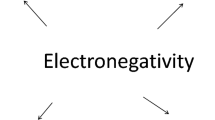Abstract
Examples are given of applications by Pauling, Mulliken, Marcus and G.E.Kimball of the three Pythagorian means to formulate the scales of electronegativity of the elements, to the calculations of rate constants of electron transfer cross-reactions, to the calculation of the observed rate constant as function of activation and diffusion rate constants in the case of mixed reaction-diffusion rates and to the calculation of the effective diffusion coefficient in solution of a salt AB as a whole from the diffusion coefficients of the ions in which it dissociates.
Similar content being viewed by others
References
Collins, F.C., Kimball, G.E.: Diffusion-controlled reaction rates. J. Colloid Sci. 4(4), 425–437 (1949)
Di Giacomo, F.: Introduction to Marcus Theory of Electron Transfer Reactions. World Scientific Publishing, Singapore (2020)
Marcus, R.A.: Discussion comment on mixed Reactions-Diffusion Controlled Rates. Discuss. Faraday Soc. 29, 129–130 (1960)
Marcus, R.A.: On the theory of oxidation-reduction reactions involving Electron Transfer.V. Comparison and Properties of Electrochemical and Chemical Rate Constants. J. Phys. Chem. 67, 853–857 (1963)
Marcus, R.A.: : Electron transfer in homogeneous and heterogeneous Systems. Phys. Chem. Sci. Rep. 1, 477–504 (1975)
Mulliken, R.S.: A New Electroaffinity Scale; together with data on Valence States and on Valence ionization potentials and Electron affinities. J. Chem. Phys. 2, 782 (1934)
Mulliken, R.S.: Electronic structure of molecules XI. Electroaffinity, Molecula Orbitals and Dipole moments. J. Chem. Phys. 3, 573 (1935)
Pauling, L.C.: The Nature of the Chemical Bond. Cornell University Press, Ithaca,New York (1960)
Author information
Authors and Affiliations
Corresponding author
Ethics declarations
Conflict of interest
The author declares no competing financial interests.
Additional information
Publisher’s Note
Springer Nature remains neutral with regard to jurisdictional claims in published maps and institutional affiliations.
Rights and permissions
Springer Nature or its licensor (e.g. a society or other partner) holds exclusive rights to this article under a publishing agreement with the author(s) or other rightsholder(s); author self-archiving of the accepted manuscript version of this article is solely governed by the terms of such publishing agreement and applicable law.
About this article
Cite this article
Di Giacomo, F. On how some fundamental chemical concepts are correlated by arithmetic, geometric and harmonic means. Found Chem 25, 265–268 (2023). https://doi.org/10.1007/s10698-023-09466-x
Accepted:
Published:
Issue Date:
DOI: https://doi.org/10.1007/s10698-023-09466-x




